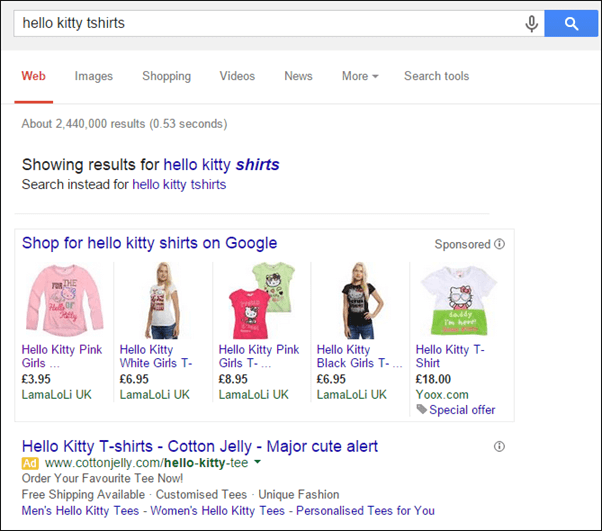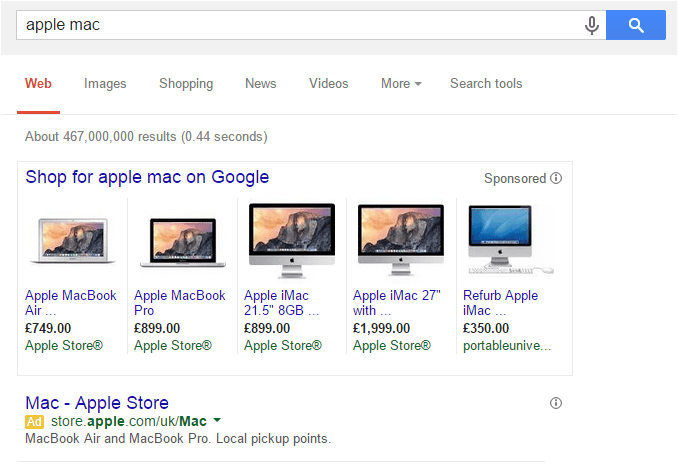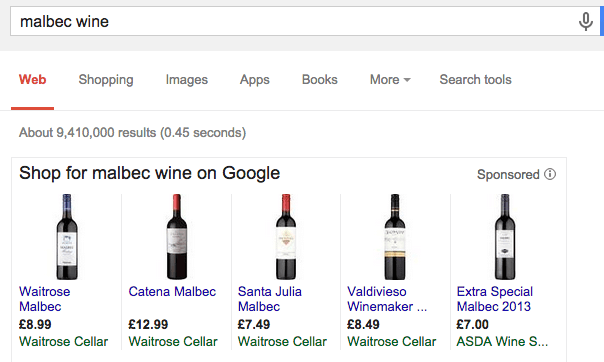Appearing Multiple Times In Google Shopping: The Pros & Cons
Are you bleeding money or gaining exposure from showing up multiple times in Google Shopping results? Rebekah Schelfhout shares her thoughts.
Recently, I’ve been asked by a few clients why they would want to appear in Shopping listings multiple times. There are, of course, pros and cons to this; however, I’m mainly in favor of appearing more often in the listings.
Why You Would Appear More Than Once
If, like in the example below, you sell multiple products that fall under the same generic naming category, then there is a chance you could be appearing more than once in the shopping results.
On the other hand, if someone searches on a more granular term, and you only sell one version of that item (as in the example below), then you’ll usually only appear once in the listings.
Having multiple variants of items within a category doesn’t necessarily mean you’re going to dominate the shopping real estate, though! There are many other factors involved here, but the main ones are your bids and also how your feed is constructed.
Google picks up information from your product titles and descriptions; so, if you have a range of products that fall under one generic search term and you have that term in more than one product title, for example, then you’re more likely to show up for multiple listings.
Depending on how you have set up your Google Shopping campaign, you can also be very granular with the bids that you set for different products in order to try and show one product over another.
Why Showing Up Multiple Times Could Be Seen As Bad
One line of thinking is that appearing multiple times in the listings could be a bad thing because people that click on the first product ad might not find what they’re after; then, they’ll click back and move on to clicking through all the other product ads till they get to the product they want.
This is unlikely to happen when your product is unique to the search people type in; for example, with the search below, a user would most likely compare prices visually using the shopping listings and then click through to the one with the lowest price.
If this price wasn’t as clear as advertised and there were any hidden costs, or there was an issue with stock, then the user might click back and choose another listing. This is the beauty of shopping — you can find what you need much more quickly due to the easy price and visual comparisons.
If the search term wasn’t so specific, such as in the example below, then it could very well be the case that people would click on one listing, read more about the product, then click back and browse other listings until they found the product they liked. This could be seen as a greater expense because of the additional clicks through multiple ads.
Why You Would Want To Appear More Times In The Listings
Complete ad domination! In my eyes, if you can dominate this prime advertising space, then you’re winning. As long as you’re showing relevant products to the search that is being performed, then showing more often is always better than just once. This is because you’ll be knocking your competitors out of this position, which is pure gold.
In the example below, you can see The Apple Store are well aware of this and have positioned themselves well to take up almost all the advertising slots in Google Shopping. If it wasn’t dominating there, then any one of the other electronics stores selling its products could also be showing up.
Auction insights for Shopping has been out since November and will give you a good indication of whom you’re competing with in this field. In order to narrow down the number of others competing with you, my advice would be to show up more than once.
Appearing more than once isn’t just great for fighting off competitor activity — it’s also really good for the consumer as you showcase the range of products that you’re selling. In the example below, you can browse the listings on the search results page, and then choose the Malbec of your preference from Waitrose.
If none of the wines were to my taste, I would then continue my search by clicking on standard search ads and browsing more websites, or refining my search terms. This is normal search behavior, so it’s better to show the consumer the best options that you have rather than just one option.
How To Show Up More Often In The Listings
Feed optimization is key here! There is no exact science to this, but it’s important to have an understanding of the impact of the terminology in your feed on how you appear in Google Shopping.
If you want to be appearing on a generic search term like Malbec and none of your product descriptions use that term, instead of calling the products [santa julia], [Valdivieso], etc., then you will not be shown for this basic term. By including the term Malbec in the product titles Waitrose is granted a higher opportunity of appearing in the listings for that term.
As I mentioned earlier, price is also a factor. Testing in house has shown that the higher your bid, the more generic the terms you’ll start appearing for become. This is where you may want to showcase more of a range of products rather than just one item, so you give the consumers more choice.
What Other Experts Say
Ginny Marvin, paid media editor at Search Engine Land:
[blockquote]The pros of having multiple ads showing on a query in Google Shopping far outweigh the cons. There’s the branding of having your name listed multiple times, and the opportunity it lends you to bring users back to your store if their first ad click didn’t get them to buy. A somewhat higher net CPA is almost always a better option than letting the competition have your business. Multiple listings also give you more data to better position your products — why do certain products get clicked and convert better on particular queries (pricing, titles, descriptions, reviews, etc.)? It can also inform how you’re using your Related Products/”You might also like” links on your product pages.[/blockquote]
Brad Geddes, author, speaker and marketing consultant:
[blockquote]I always think about search marketing as controlling real estate so I’m a fan of showing more times in the shopping results. I sometimes see results where every ad is actually just one company. I can kind of see an argument saying that if we’re there multiple times then we’ll get more poor clicks or people will click one result, go back, and click on another one of our ads so we get charged twice. Except, that same behavior would just happen anyway – so your bidding would take care of those scenarios.[/blockquote]

[blockquote]As in the example above where all 5 spaces are taken up by the same company I would advise that this is a good thing for the client because the products shown are all visually different, they are at multiple price points and they are distinct products. However, there are cases where I would not recommend it, namely if the value proposition is very similar or the products look the same. Overall I’d generally consider this a good thing, but you need to consider each case separately. If the brand of the retailer is the major drive rather than the product, then there is a good argument for having only a small number of results showing. That said, overall, why would you want someone else to show?[/blockquote]
As a closing note, this is something which is currently impossible to test via A/B testing as Google gives us little visibility on how many times we appeared for each individual auction.
It would be great to be able to see some more information on this in the future so that it can be tested in more detail; but for now, I would advise on gut instinct that showing up more often is better than once when it comes to more generic searches for products.
Opinions expressed in this article are those of the guest author and not necessarily Search Engine Land. Staff authors are listed here.
Related stories






